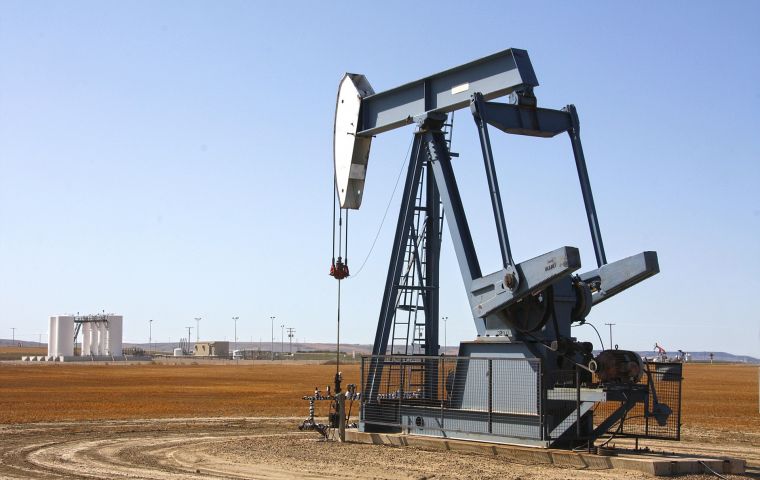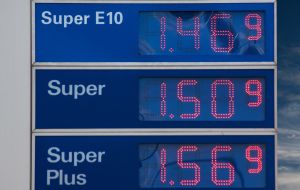MercoPress. South Atlantic News Agency
What is the economic fallout from the Saudi Arabia oil facility attack?
 While the political consequences of this attack remain critical, the economics of such an event are also being felt throughout the world. Image: Pixabay
While the political consequences of this attack remain critical, the economics of such an event are also being felt throughout the world. Image: Pixabay The rising oil prices will unfortunately have a short-term impact on gas prices at the pumps. Image: Pixabay
The rising oil prices will unfortunately have a short-term impact on gas prices at the pumps. Image: PixabayA violent attack on Saudi Arabia’s oil infrastructure was carried out earlier this month. Some 18 drones and seven cruise missiles were reportedly fired in the direction of several oil facilities in the region. The Abqaiq facility was the primary location of attack, while cruise missiles struck an oilfield in Khurais, just east of the city of Riyadh.
Since the attack, rumours and reports have persisted, stating that Iran was behind the attack. However, the Iranian government vehemently denies involvement. Despite their rebuttal, Saudi Arabian defense ministers believe they have proof that the drones and cruise missiles could not have been fired from Yemen. Meanwhile, the debris of the missiles is also said to incriminate the Iranian government.
While the political consequences of this attack remain critical, the economics of such an event are also being felt throughout the world. In fact, immediately after the Saudi oil attacks, the price of oil surged steeper than at any point in the last 30 years. Here's a breakdown of some of the facts:
● It was the biggest price rise of crude oil in a single day since 1988
● Brent crude rose by over $12 per barrel within a matter of seconds of trading in London.
● It reached highs of $70.88 a barrel, which equated to a rise of almost 20% in the space of 24 hours.
In the financial markets, traders sought to place oil futures trades on the price of oil in a bid to hedge against further market volatility, while the political fallout from the attack rumbles on. The price spike of Brent crude also had a knock-on effect on the global energy sector, with shares in energy providers driven north amid the potential for greater profits. However, several other stocks fell into the red as a consequence of investor panic amid the frosty geopolitical climate.
How could a persistent price surge on oil affect the U.S. economy?
The American economy has remained largely buoyant thanks to consumer demand. Although some businesses have sought to drop down a gear or two, consumers have bucked the trends and kept their wallets out. Nevertheless, persistent volatility in the oil markets could be the straw that breaks the camel’s back in terms of consumer confidence, leading to an increased risk of recession. Steve Blitz, chief U.S. economist at T.S. Lombard, said that the news “adds a negative to the outlook” of the wider U.S. economy.
The rising oil prices will unfortunately have a short-term impact on gas prices at the pumps. Tom Kloza, global head of energy analysis at the Oil Price Information Service, believes that consumers can anticipate paying around $0.20 more per gallon than before the attack. Some might be wondering why the price of gas hasn’t already realigned with the market volatility, but the higher crude values are not expected to affect pump prices until late September/early October.
Nevertheless, when you factor into the equation multiple issues, this could equate to quite a significant price-hike for the everyday American.
1. The average family across the U.S. will use at least 90 gallons of gas per month, so households are likely to spend nearly $20 more for their gas in October.
2. The price of Brent crude soared by more than $12 a barrel, but if it was to rise by as much as $25 a barrel in the coming weeks or months, the magnitude of this move could pose a significant threat to the U.S. economy, curbing spending as a result.
3. It’s one of several reasons why many anticipate the Federal Reserve cutting interest rates by 0.25% this month.
Spiking oil prices could also curb India’s economic recovery
The fact that 5.7 million barrels have been wiped out production a day could also have a knock-on effect on the Indian economy. This equates to around a fifth of the world’s overall crude oil supply being cut and Saudi Arabia could be forced into capping their oil supplies further still if the geopolitical tensions continue to rise. This would be a huge blow to the Indian economy, given its reliance on importing oil from Saudi.
There are more than a few problems with the spike in relation to long standing economic recovery.
● Almost four-fifths of India’s oil is imported into the country.
● Much of its crude oil and cooking gas is supplied by Saudi Arabia.
● According to data from the Indian Petroleum Planning and Analysis (PPAC) oil consumption nationwide reached more than 211 million tonnes, compared with the country’s crude output of a little over 34 million tonnes.
● Taimur Baig, chief economist for Singaporean DBS Banking Group, believes that even a modest 10% rise in global crude oil prices would affect the Indian deficit by as much as 0.5% of GDP.
The bigger picture for India is that while some other economic powerhouses such as the U.S. and China may have sufficient oil reserves to cope with market headwinds, India almost certainly won’t. The people of India will no doubt be crossing their fingers that market conditions don’t worsen, otherwise, it could accelerate an economic downturn that’s resulted in kneejerk job losses in several business sectors.




Top Comments
Disclaimer & comment rulesCommenting for this story is now closed.
If you have a Facebook account, become a fan and comment on our Facebook Page!